A deep data dive reveals a disorganized and agonizingly slow process for rebuilding funds promised to 552,812 households after Nepal’s devastating earthquake. Funds have been distributed unevenly throughout Nepal’s districts, particularly to marginalized ethnic communities. Frequent changes of governments, confusing regulations and lack of trained workers also contribute to long delays.
The Nepal government promised to spend 938 billion Rs on reconstruction. Yet only 30 billion Rs – less than 3 percent — has been spent so far. Many earthquake victims have waited more than 21 months without receiving any funds to rebuild; others have received only a first installment. Meanwhile, more than 15,000 men, women and children shiver through a second winter in camps of tents and metal shacks.
Scroll through each District to see: total number of listed beneficiaries, number of households that have signed grant agreements, number of households that received the first grant tranche, and the number of grievances.
While seven reporters collaborated on data, they each produced individual stories for his or her media outlets. When viewed together here, these multimedia reports present a detailed and nuanced analysis of how Nepal’s slow recovery is hurting ordinary people.
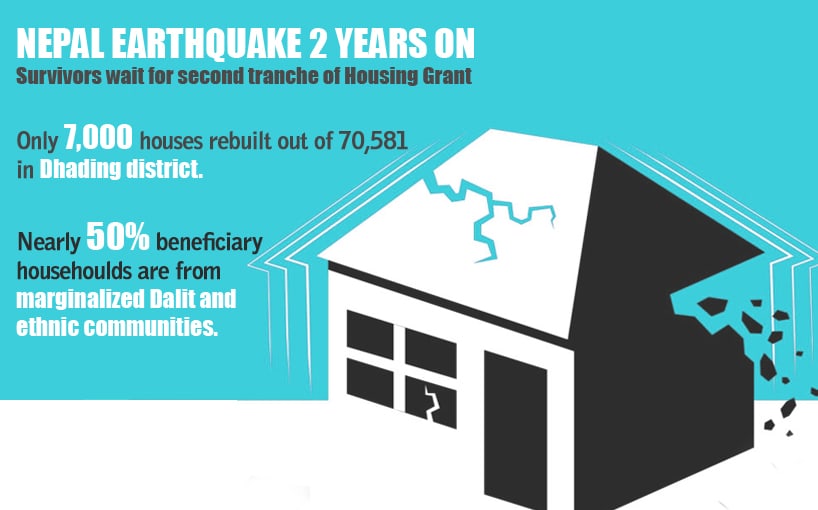
As her ancestors have done for centuries, Sita Nepali takes manure from a bamboo basket to scatter and fertilize her land in an age-old practice of subsistence farming. She takes a brief breath of relief when she returns to her house – but does not go inside the shattered structure.
Read More
We are scared to sleep inside because the walls are badly cracked, the 40-year-old Sita says. We never know whether they will fall down.
Since Nepal’s destructive earthquake two years ago, she and her family of four spend cold nights outdoors, guarding their cooking provisions and utensils.
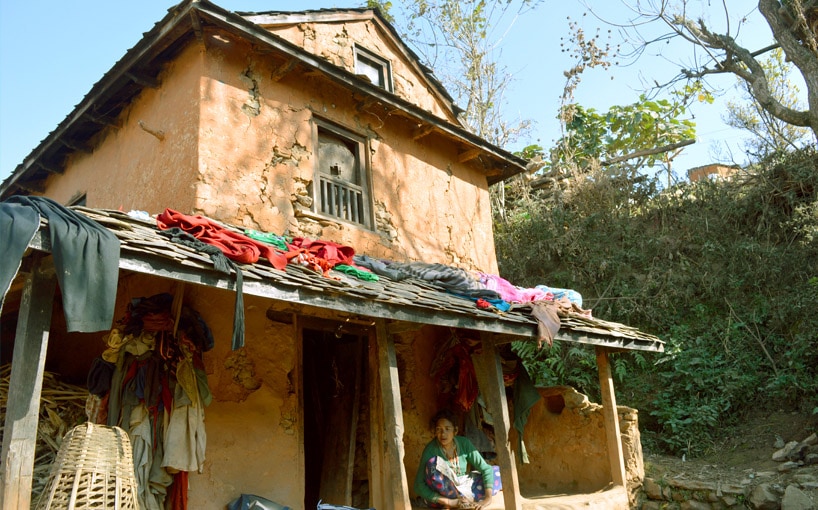
Sita Nepali sitting outside of her cracked house | Photo: Arun Karki
Her family is one of 127 lower-caste or ‘Dalit’ households in the Tarukharka village in Dhading, one of the districts hit hardest by the April 2015 earthquake. All 127 houses were destroyed or severely damaged, forcing the entire community to liveoutside, or in tin and wood temporary shelters tucked into terraced, steephills.
According to national statistics, 70,581 households in Dhading are eligible to receive grants to rebuild their houses. But only ten percent of beneficiaries have finished rebuilding houses, according to the National Reconstruction Authority. Nearly half of the beneficiaries are Dalit or members of another marginalized ethnic community.
Although the village is only 90 km from the capital city of Kathmandu, Dhading is a backward district, remote villages inaccessible by road, and with limited access to water.
The National Dalit Commission of Nepal describes the Dalit community as “traditionally subjected to untouchability and caste-based discrimination, and also extremely marginalized, excluded or deprived in social, cultural, political, education, administrative or economic sectors and deprived of social justice.” That marginalization has extended to government relief after the earthquake.
Last October, Sita’s family received government housing grant money of Rs. 50,000 ($500 USD) as the first of three installments. But even so, they could not start to rebuild.
We don’t have enough money, she explained. It would cost more than Rs. 1,000,000 ($1,000) to pull down the house. If we can’t rebuild soon – in at least a month — after demolition, where would we go and stay?
Her husband earns about Rs. 6,000 ($60) a month as a porter, transporting heavy loads into the hills on his back. Like many youths in Dhading, her eldest son quit primary school and left for Delhi where he found a dishwashing job, earning another Rs. 6,000 a month.
For now, building a new house remainsa distant idea. They have no idea when they will be able to demolish the cracked house and start over.
Juthe Sarki, 50, another Dalit from the same village, has spent more than Rs. 50,000 ($500) to demolish his cracked house and clear away the debris. Last year, he was excited about rebuilding when the Nepal government announced it would provide a housing grant totaling 300,000 rupees for each beneficiary household.
I thought the grant money would be enough to build a simple two-room house. If not, then I thought borrowing might be the option, Juthe said.
His enthusiasm and courage disappearedwhen he saw a sample earthquake resistant house built nearby in Charaudi on the Prithvi Highway, just 30 km away from Dhading district headquarters.
Recently erected but consisting of only a ground floor, the model house was built by a partnership between Oxfam and the local NGO, Prayas Nepal. Juthe Sarki said he felt like he was suddenly falling from a tall building when he heard that such a small and simple house could cost up to Rs. 1.4 million ($14,000).
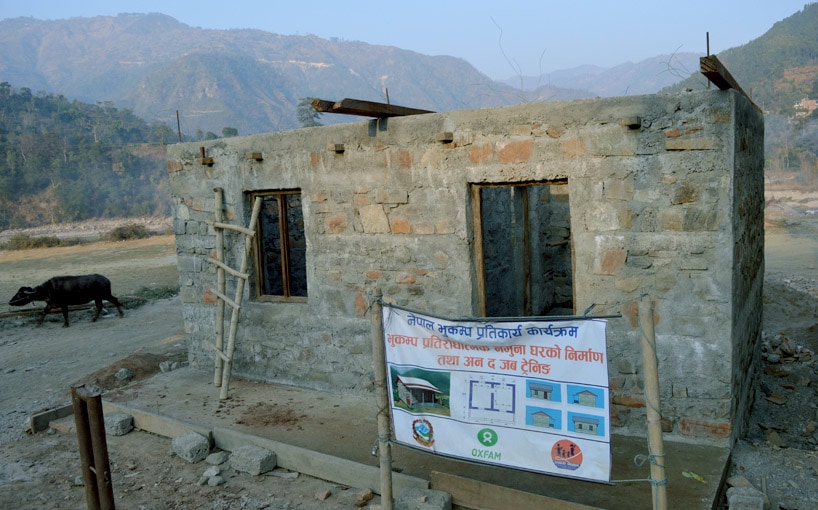
Earthquake resistant model house constructed at Charaudi, Dhading | Photo: Sunil Dhungana
I would have guessed that it would not exceed Rs 500,000 to build like that, Sarki said. I am terrified. The cost is too high for me. I think I will never make this kind of house.
Ganesh Bika of the Prayas NGO explained that that the model house was one of 17 government-approved seismic-resistant designs. The 42 square-meter house consists of two rooms that could accommodate a family with five-to-seven members. Sixteen masons were hired for a three-month on-the-job training program to build it. All required construction materials were purchased by Prayas Nepal itself.
In Tarukharka village, none of the Dalit families have begun rebuilding homes. Most of the villagers have spent their first grant installment to demolish their houses, dig foundations and manage the wreckage.
Their common demand to authorities is to receive the rest of the grant money at once, contending that it would help them begin reconstruction.
Juthe reckons that, including the cost of transporting construction materials, he will need at least Rs. 1 million to build a stronger and better home.
But Dilip Bhandari, head of Building and Urban Development office for Dhading quoted the strict policy of the National Reconstruction Authority that forbids disbursement of the rest of the grant money ($2500) at once, to prevent possible of misuse of funds. If someone has finished rebuilding a house as per the building code set by NRA, then he/she can receive the whole, or remaining amount. He further explained that beneficiaries canreceive subsidized low-interest -rate loans from banks in case.
Meanwhile, the people of Tarukharka try to find other ways.
Somlal Saru Bisunke, a primary grade dropout from the Tarukharka school, had returned from India after seven years. Now he plans to leave again, for Qatar to make money for a new home.
Four of his seven brothers are still in India, one is in Qatar and two are in Nepal. While the brothers are absent, their wives face problems getting even the first grant installment, due to incomplete papers. Somlal said that 20 other Dalit families in Tarukharka are grappling with similar issues.
Over the past ten years, 30 percent of the people in Dhading have migrated abroad for foreign employment, mostly on labor jobs in Arab countries, according to a labor migration report published in 2015 by the International Labor Organization. The number is probably higher, because migration data to India is not traceable, due to an open border policy. India is a common destination for many Nepalese seeking work.
Rainy season is very near, when transport and building becomes impossible. After two years of waiting for relief, the Tarukharka Dalits express their frustration and fury that the response by government authorities has been so very slow.
Whenever strangers visit Tarukharka, the villagers hope that it is somebody coming to provide grants.
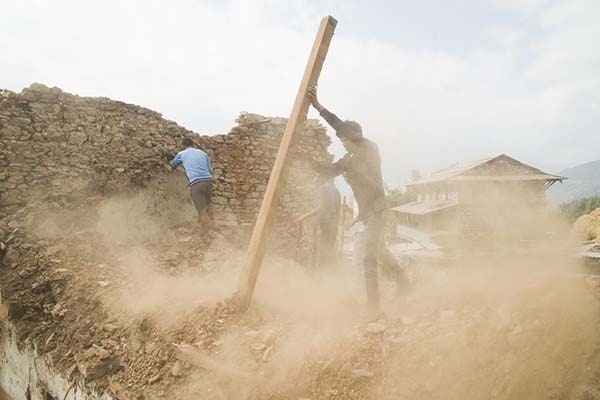
Reconstruction work in Dolakha
Earthquake survivors wait for reconstruction grants that are too little too late
RAJNEESH BHANDARI in SINDHUPALCHOK
It’s midnight. Rain is making a din on the tin roof of Kanchaman Dong’s one-room, four-bed shelter. This has been his family home for the past two years after the April 2015 earthquake.
Kanchaman tried to ignore the rain and cold, and just hoped for a warm sunrise in the village of Duwachaur, a jolting 8-hour ride across a rough mountain road. The earthquake killed seven members of the Dong community in Duwachaur: every household lost someone. A Lalitpur-based relief agency promised to rebuild the 36 homes destroyed here, but after making nine tin-roof huts, it didn’t come back.
Karun Tamang, 24, holds the picture of his mother who died in the April 25, 2015 earthquake.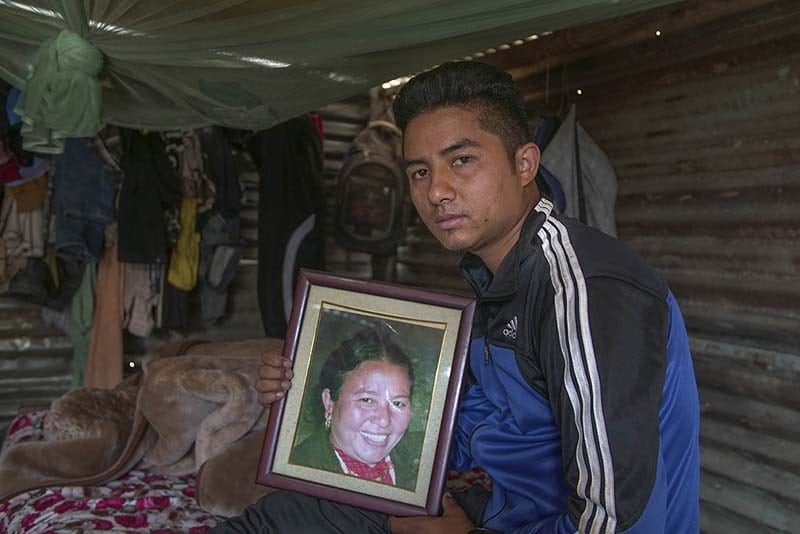
The relief agency says it left construction material for the remaining houses but had to abandon the project because of a disagreement with villagers about their contribution to the reconstruction effort. It also says the Chief District Office in Chautara didn’t show much interest in the help it was bringing.
Duwachaur is a story repeated right across the 14 earthquake-affected districts. It is a tale of how after initial interest, the government, aid agencies and relief groups slowly lost interest in helping survivors.
Tek Bahadur Mahat, 33, is reconstructing his house destroyed by earthquake in Thokarpa, Sindhupalchowk, one of the worst hit districts by Nepal earthquake.
Meanwhile, Kanchaman Dong has just got the Rs 50,000 first instalment of the government reconstruction grant, but it isn’t enough to buy the needed materials. In many earthquake-hit villages, the first instalment has been spent to buy food and essentials, and the rebuilding never started.
Reconstruction work in Dolakha
Kanchaman Dong’s biggest item of expenditure is labour and transport costs. He says:
It is the transportation cost that keeps me afraid of attempting to build a house.
On the other side of the mountains from Duwachaur, in the village of Thokarpa, Tek Bahadur Mahat, 33, is rebuilding a one-storey home with help from his family members. But the Rs 50,000 is long gone. Mahat has already spent Rs 300,000 on 10 trucks of sand and gravel, Rs 200,000 on bricks, Rs 300,000 on iron rods, Rs 250,000 on cement and Rs 250,000 on timber for windows and doors.
Reconstruction work in Sindhupalchowk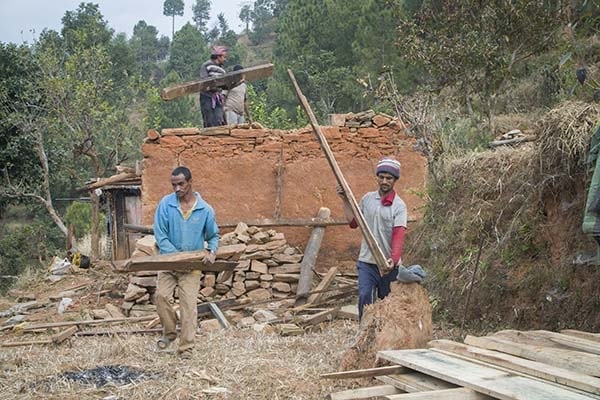
By the time his house is finished, Mahat’s home will cost five times more than what the government has promised in reconstruction grants.
The Ministry of Urban Development’s Design Catalogue for Reconstruction of Earthquake Resistant Houses has designs for homes made of stone and mud mortar, brick and mud mortar, stone and cement, and brick and cement. The cost to build these seismic-resistant designs is between Rs 1-3 million.
Reconstruction in Kathmandu is even more expensive. Umesh Maharjan from Lalitpur is building a six-room house after his previous one was damaged in the quake. He hired a contractor for Rs 3.5 million to rebuild his house – 10 times more than the grant he is getting from the government.
Reconstruction work in Sindhupalchowk
A government estimate showed that 602,257 houses were destroyed, and 285,099 houses partially damaged. It pledged Rs 200,000 in three instalments for reconstruction, and last year Prime Minister Pushpa Kamal Dahal raised that to Rs 300,000.
But after two years, the government grants have been used to complete only 18,315 houses, while 34,732 are under construction. “The cost of making a house with the seismic-resistant design will cost more in rural areas because of the transportation cost of the materials,” said Machaman Dangol of the Department of Urban Development.
Both in villages and cities, it is clear that the government grant, even when it does finally come, will not be enough. After completing their houses, both urban and rural builders have one thing in common: wait for the remaining grant from the government, and take on a huge debt for the remaining amount.
Tek Bahadur Mahat in Thokarpa, for instance, invested half of the amount from his savings and took loans of Rs 700,000 from friends to build his house.
I hope the rest of the reconstruction grant will be useful in repaying the debt in 2-3 years with interest,” Mahat said. “The government’s Rs 300,000 doesn’t even buy the roofing material.
In Kathmandu, Yubaraj Khatiwada, former governor of the Nepal Rastra Bank and ex-chief of the National Planning Commission, is worried that indebtedness will rise in households with no other source of income.
The households without remittance income, no surplus cash crops or no local business, and those who do not qualify for housing grants for one reason or another, will be worst hit.
Many genuine earthquake survivors are missing from the list for housing grants due to frequent changes in government
Read MoreThe flimsy tent doesn’t protect Rameswor Pudasaini and his family from the biting cold and wind, but nearly two years after the 2015 earthquake he has resigned himself to treating this as his home. There are dozens of families here in Jiling of Nuwakot district who have found out that their names are not on the list of survivors entitled to receive even the first installment of the Rs 200,000 government reconstruction grant. There is renewed hope in many of the 14 worst-affected districts that with the changing of the guard at the National Reconstruction Authority (NRA) and the reassignment of Govinda Raj Pokharel as CEO, the remaining money will materialise. But not here. “My house was certified unsafe by engineers, but my name is not included in the government’s list,” says Pudasaini, “I don’t understand why, when even people without land ownership certificates have got their Rs 50,000 first installment.” For now, all he can do is file an appeal at the NRA, but seeing the slow pace of relief, he is not very hopeful. For now, he has taken loans to rebuild a small house from salvaged material, but says: “I cannot keep my 80-year old mother and small children in a tent for another winter.” The plight of the Pusdasaini family is in stark contrast with Prakash Dhungana in Ward 4 of Jiling. Although the government has a policy to provide housing grants only to those who have only one house that was destroyed in the earthquake, Dhungana’s name is on the grant list even though only one of his two houses was damaged in the quake.
His neighbor, Bishnu Dhungana, whose only house is inhabitable because of serious damage, also found out his name not on the list. Like many other earthquake families in Nuwakot, he doesn’t know why. Although most of the 600,000 families who have registered have got the first tranche, there are many like Pudasaini and Dhungana who have somehow fallen between the cracks because they cannot work the system. Prakash Dhungana is a teacher and says: “I don’t understand how they decide. Some people have received grants while others haven’t even though the damage to our homes are the same.” He blames engineers deployed to inspect the houses, saying they lacked experience. Subba Tamang, 31, of Jiling has no idea how to get on the list and be eligible for a grant. Engineers told him his house was unsafe, and he spent Rs 70,000 building a temporary structure for shelter from the rain and cold. But he never got the Rs 50,000 his neighbours have. “We waited a long time, but it seems we need political connection to get the reconstruction grant,” Tamang said. Nearly 500 households in Jiling and surrounding villages have appealed, and many of them were omitted because the inspectors failed to certify them. The NRA has identified 626,036 households in 14 earthquake-affected districts as being eligible for reconstruction grants. Of them, 452,887 have received the first tranche of Rs 50,000.
Map: CIJ On Tuesday, the NRA announced it would start distributing the second tranche in Gorkha, Sinduli and Makwanpur. In Nuwakot, 50,972 of the 65,759 families identified as beneficiaries have got the grants. The Pudasainis, Dhunganas and others fall outside this list. The NRA sent 2,000 engineers to the 14 districts and each surveyed 10 to 12 houses a day. Around 200 engineers were deployed in Nuwakot alone for two months of fieldwork, but they seem to have missed out on 32 households in Jiling. Ram Chandra Dhungana heads a struggle committee of victims who have not got compensation, and blames the incompetence of engineers. The delays in distributing the rest of the Rs 200,000 grant and including eligible families who are not on the list points to government negligence and mismanagement. The buck stops in Kathmandu, and the NRA is getting a new chief every time the government changes. Pokharel was appointed by the Nepali Congress government in 2015 and was sacked when KP Oil became prime minister, and was replaced by party aparatchik Sushil Gyewali. When the NC switched sides and joined the Maoist-Centre in the coalition, Gyewali faced obstacles in relief delivery. He was finally sacked last week, and Pokharel re-appointed. Post-earthquake rehabilitation is suffering due to conflict between the parties in Kathmandu that trickles down to the districts. In addition, the sluggish bureaucracy and lack of coordination between line ministries have also left survivors in the lurch. When asked about what will happen to the victims interviewed by Nepali Times, Pokharel told us in an interview no genuine earthquake victim would be left out in his watch. He said he would re-do the inspections in Nuwakot if necessary.
The survey was a waste of time and money because a lot of real victims seem to have been missing in the grant list due to technical errors,
he admitted.
real victims should not be missed out, and I will address this issue within one month.
“We also need socio-economic reconstruction”
The newly re-appointed CEO of the National Reconstruction Authority Govinda Raj Pokharel is a busy man because he has to make up for lost time on post-earthquake rehabilitaiton. He spoke to Nepali Times on Monday at his office.
Nepali Times: What did we lose in one year? Govinda Raj Pokharel: We failed to utilise the immense opportunities that we had amidst the crisis. We couldn’t adopt an integrated model settlement which could have saved our infrastructure cost per houses. The NRA has already distributed the first tranche of the housing grant and we can’t undo this now. Since we couldn’t implement the integrated model settlement, people have lost livelihood opportunities. Likewise, massive training should have started as soon as the NRA was formed last year and at least 25 masons should have been ready in each ward by now. People are skeptical about how much you can achieve because you inherit the same system from your predecessor. I have just started free health checkups in the earthquake affected districts. The mason training will start to train as many masons as possible. The second tranche of the housing grant will be parked in the district office so that they receive it directly. The current process is too lengthy. At least 7,000 fresh graduates from CTEVT (Council for Technical Education and Vocational Training) will be sent to the earthquake affected districts as volunteers to help people rebuild. How are you going to pick up where you left off last year? We have been very successful in terms of rescue and relief. However, there are certain lapses in reconstruction. I am planning to clear the complaints within a month. The main challenge is to settle the cases related to rented and Trust land, and people who don’t have land ownership certificates. I will form a special committee to address those issues and come up with concrete solutions. Where would you like to see reconstruction in the next six months? Our immediate target is to provide as many houses as possible to earthquake victims by the next monsoon by fast tracking reconstruction. The security forces are committed to help us train masons. We must improve the supply chain to ensure smooth supply of reconstruction materials. Private housing is only 2.5 per cent of reconstruction, we also need socio-economic reconstruction. Our long term plan is to ensure that people have sources of income wherever they are resettled. We need to look at restoring livelihoods. Video: Watch the re-appointed CEO of the National Reconstruction Authority (NRA) Govinda Raj Pokharel responding to the woes of earthquake victims who haven't received the government's housing grant
Center for Investigative Journalism
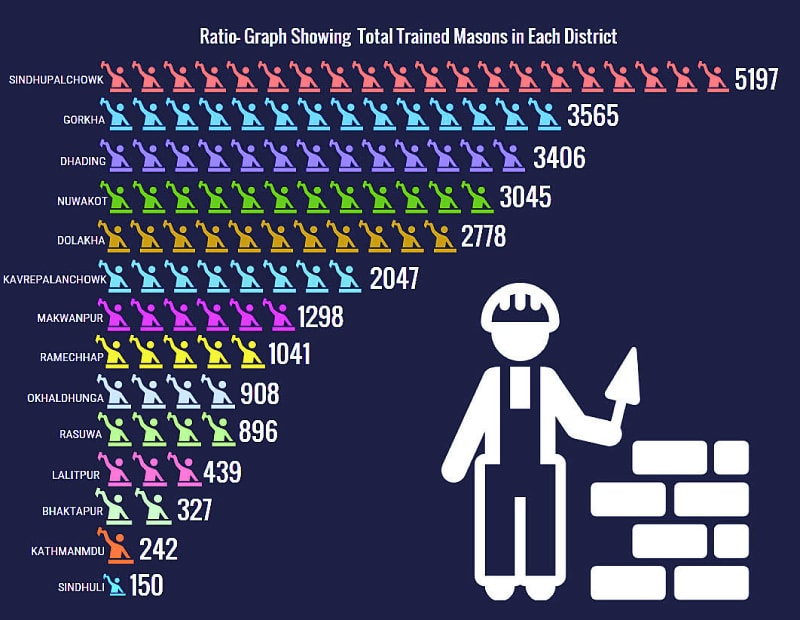
At current rate, each trained mason would need to build dozens of houses a year
SINDHULI, Jan 31: When he received the first installment of the reconstruction grant in September, Jhamka Bahadur Thapa planned on moving into a new, warm house before winter arrived.
He, his wife, and four-year-old daughter have been living in a makeshift shelter of corrugated metal sheets since the April 2015 earthquake. His daughter often sneezes from frequent colds, made worse by the damp that seeps through the roof and soaks all their belongings. Although Thapa had already stockpiled wood and stones, and took out a loan at an exorbitant rate, he couldn't begin building last fall – and still cannot begin now. Why? Because no masons trained in earthquake-resistant building are available. Almost every one of the 34,256 Sindhuli-district households whose homes were destroyed by the earthquake wants to start rebuilding. But they, too, are waiting for masons and other laborers. Some have lost hope and started rebuilding with untrained bricklayers, even though this means their new houses may be unsafe. As of December 25, only 150 trained masons were working in Sindhuli district. Masons interviewed said a team of four masons is needed to build one house, and that each team could only construct three to seven houses a year. At that rate, it would take at least 130 years to rebuild all 34,256 houses in Sindhuli. Reconstruction of individual houses will be slowest in Sindhuli amongst all the 14 earthquake-damaged districts.
But Sindhuli is not alone in facing a shortage of trained masons. "More than 1,100 households in Sindhukot village, Sindhupalchowk, want to rebuild their houses now, but scarcely 50 masons are available”" said Madhusudan Sigdel, a local leader of Nepali Congress in Melamchi Municipality. Similarly, building quake-safe houses may take at least 100 years in Kathmandu, which has only 242 trained masons to rebuild 42,500 quake-damaged houses. Do the math: Available manpower can only build 423 houses in a year in Kathmandu. Government officials acknowledge the need for more mason training programs but say they have not set aside enough money to fund them. Forty-seven NGOs and INGOs organized training courses for masons to learn building techniques to make houses more resistant to earthquake damage. In all, 25,393 masons have so far been trained since NGOs and INGOs started training in January 2016, according to the latest statistics, compiled in December 2016. The trainings were divided into two types: short, seven-day courses for traditional masons to update them on new techniques; and a 50-day vocational course for 4,359 novices, according to figures compiled by Housing Recovery and Reconstruction Platform (HRRP) Nepal, which coordinates NGO and INGO training programs. The training used a learning-by-doing method, during which the masons built real houses. Data analysis shows that mason trainings have not been distributed throughout the 14 districts in proportionality to the damages suffered in each district. In Sindhuli, for instance, 150 masons underwent training, to rebuild the 34,256 destroyed houses in the district. But in Sinhupalchok, 5,197 masons were trained, to rebuild 78,537 houses, according to National Reconstruction Authority (NRA), the central agency for reconstruction. That means Sindhupalchowk, in the north of Nepal bordering Tibet, trained 34 times more masons that Sindhuli, in the south bordering India, to build only twice as many houses. Chandra Bahadur Shrestha, an NRA executive committee member, acknowledged the yawning gap in manpower needed to rebuild. "We had planned for training of 30,000 masons before housing reconstruction grants were distributed, but the Ministry of Finance took it lightly and we are yet to get the budget of Rs 2 billion for the purpose," said Shrestha. "The training is important for safe rebuilding but it was not taken seriously," he lamented. But Ministry of Finance (MoF) officials however do not agree with Shrestha's statement. Secretary at MoF Shanta Raj Subedi said, "Budget is not an issue, as NRA has enough budget of total Rs 174 billion for the current fiscal year and NRA also can restructure if necessary while spending," said Subedi adding that NRA has got needful budget allocation including for masons training. NRA officials had initially tried to monitor and regulate all NGOs and INGO activities including training programs in the districts, but it received huge criticism from civil society for its delayed response. Despite no less quake damage, Sindhuli and Makawanpur have got less in emergency relief packages and also less exposure to NGOs and INGOs in receiving reconstruction activity in that district," said Binaya Bogati, Information Management Officer at HRRP-Nepal. Meanwhile, the government has set a goal of rebuilding earthquake victims' houses in five years. Yet the government has yet to come up with an intensive program to train the manpower needed for reconstruction. Likewise, NRA has separately asked JICA, Helvetas, India and USAID for organizing trainings for another 30,000 allocating area specifics but this has yet to materialize. Shiva Hari Sharma, project director of NRA's Central Level Project Implementation Unit, said that government planned to train a total of 30,000 masons but does not have the budget to do so. "Initially we are going to start the training in Nuwakot, Dolakha and Dhading with a fund received from the World Bank” he said.
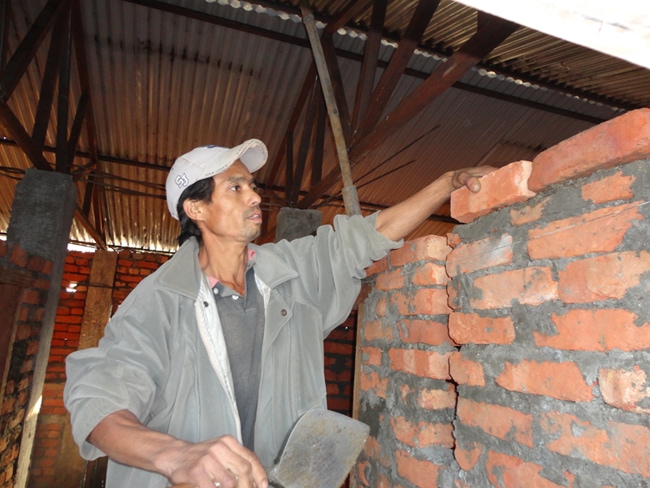
Subba Ale Magar of Gwaltar Sindhuli is untrained and is laying walls in a house, this shows building safe homes is not going to happen as expected
Everything ready, except for a mason While Jhamka Bahadur Thapa, 30, and his family lived through adverse weather in Sindhuli – one hot summer and now, two winters – he salvaged reusable wood and stones from his flattened house. "I have prepared the land and dug foundations and collected sand and aggregates for building a mud and mortar house of three rooms as prescribed by the Nepal Red Cross Society, but I have not yet found any trained mason," he said. In the months after the 2015 earthquakes, the government initially decided to award Rs 200,000 to eligible residents whose homes were destroyed in the 14 quake-damaged districts. The government and donors agreed to increase that amount to Rs 300,000 in September 2016, to be distributed in installments of Rs 50,000, Rs 150,000 and Rs 100,000. The first of three tranches only began to be distributed in May 2016, and continues at an uneven pace. Thapa knew the government would be slow to distribute the second and third tranches of funding, so he borrowed Rs 50,000 from a local lender so he could quickly rebuild his house when he received the first installment in September. He is paying a 24 percent interest rate on the loan, which is more than twice the current market price of commercial banks. Thapa, who is traditional farmer and occasional poultry farmer, now has no idea when he will be able to hire the manpower he needs to start building. Arjun Thapa, a resident of Bhuwaneshwary VDC, received his first tranche in November but also has not found trained masons to rebuild his house. He also has already assembled needed materials for rebuilding. Rebuilding a house of mud and mortar requires at least four masons, who working in a team with other laborers, can build only three to seven quake-resilient houses in a year, according to half a dozen trained masons involved in rebuilding. "A team of four trained masons can only build a maximum seven houses in a year, said Ram Bahadur Bhujel, a traditional mason who received earthquake training. Bhujel, 57, participated in the seven-day masonry training organized by NRCS in June last year. "Since June, I have been working with three other trained masons and we are now building our third mud and mortar house," said Bhujel, a powerfully-built man with a thick, salt-and-pepper mustache. Other masons said that the number of houses they can build in a year may be as low as three if there are not sufficient laborers to support them. "We are three, working on two houses now and it may be hard to complete three houses a year”" said Lal Bahadur Ramtel, another trained mason. Building is disrupted by monsoons and the October festival season. Trained masons lay bands for strength Bhujel has found NRCS training useful. He said, "I came to know a few techniques of applying different bands — either of wooden or reinforced concrete – and of using tie beams for strengthening the structure in the house”" A band, also known as a ring beam or a belt, ties together the walls of masonry or adobe construction for added earthquake resistance. It is typically made of wood, or concrete reinforced with iron bars, or rocks contained in wire cages, and laid horizontally, to provide tensile strength that masonry lacks, especially at the joints between walls. Bhujel further explained, "I have learned to fix sill and lintel bands below and above windows, place solid bands in the corners of the walls, bands on the windowless walls, among others, as well as how to laying proper foundations, design appropriate room sizes, build end walls at a maximum of six feet high, and use interlocking stones for strength." Trained masons interviewed said other key things they learned included building on solid land rather than sandy soils. "I have learned that houses we made in the past lacked bands and were built on loose soil. We also showed negligence in laying foundations," said Marichman Mijar, a traditional mason of Sindhukot village in the Melamchi Municipality. Mijar attended a seven-day masonry training from the UNDP in October. Graphic: 'Years required to rebuild houses in each district with available trained masons." Data is calculated based on the mason's training data compiled by HRRP-Nepal (collected on December 25.)

Trained masons abandon work, untrained fill the gap
A total of 150 people, including 60 traditional masons, were trained in safe rebuilding techniques in the Sheetalpati VDC, Sindhuli, but only about 100 are still working as masons. "Others have gone to work as laborers in brick kilns in the capital city, while others have returned to their previous jobs," said Hasta Raj Thapa, chairman of Sheetalpati-based sub-branch of NRCS, Sindhuili. He added, "Those who went to brick kilns had already received advance remuneration for labor work in July. At the same time, masons with no earthquake training can be found rebuilding homes in Sindhuli. Several untrained masons said in interviews that they would love to go to training sessions. But the amount of trainings for Sindhuli was very limited. For instance, Subba Ale Magar, a mason by family tradition, has been working on a concrete house in his neighborhood of Bhuwaneshwary VDC in Sindhuli but never received earthquake training. "I have received several job offers to rebuild houses and I wish I could have been trained," said Magar, who is in his early 30s. Saroj Pokhrel, the owner of house currently under construction by Magar, said that he had to choose Magar because he could not find any trained masons. Netra Bahadur Gajmer, another untrained mason, is also rebuilding one concrete house in Sheetalpati and has finished another house. Experts say government's housing grants were planned as incentives for residents to build safer houses. If the residents go ahead and hire untrained masons, not only do they risk building an unsafe house – they may lose their eligibility for the second and third tranches of the housing grants. Although NRCS monitors rebuilding, Kishor Thapa, an engineer and former government secretary, said enforcing laws such as building codes is very difficult in Nepal. "Housing grants were incentives to ensure building safe houses — those not abiding by code weren't supposed get a second tranche," said Thapa, who was a key member in drafting reconstruction policy. This story was part of a Center for Investigative Journalism-Nepal project, and received a grant from the Fund for Investigative Reporting in Washington, D.C.

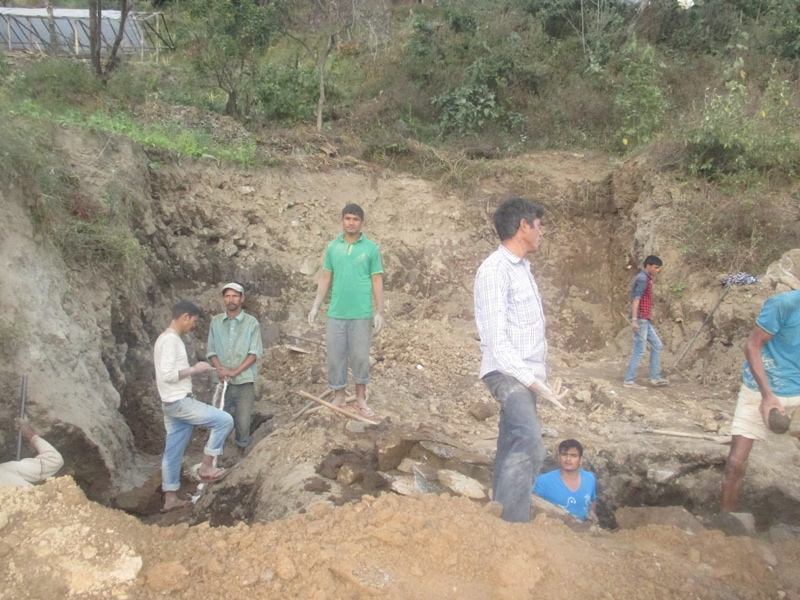
Labourers are digging trenches for foundation to rebuild a house in Melamchi Municaplity.
SINDHUPALCHOWK, Feb 1: More than 200 laborers and technicians from Nepal’s southern and more western districts of Banke and Jajarkot have flooded into quake-hit districts to rebuild houses. Some of those laborers interviewed in Sindhupalchowk report that they earn more in Nepal than they would working in the populous state of Uttar Pradesh in India.
Read MoreMany others are on the way. The workers stay for 4 to 6 months and then go back home with the money, just as they do working in the cities of northern India. Mohan Lal Budhathoki, a resident of Kohalpur VDC in Banke district, came here in October last year in search of work. In December, he and eight others from Banke and Jajarkot were digging the foundation for a concrete house in the Sindhukot village of Melamchi municipality. “We just heard that we could get some work in quake-hit districts and came here last year and we have been working here since then,” said Budhathoki.
Ganesh Gurung, a noted labor expert in Nepal said, “Movement of those jobseekers to quake-hit districts itself is an interesting phenomenon. This is a completely new trend for the people of the western hills to either migrate to lower plains permanently for easier lives, or to travel to Indian cities for jobs.” Budhathoki and some of the others from western Nepal have already built seven shelters for the Nepal Army in Khursanibari near Barhabishe, and built separate shelters for Nepal Police in Irkhu VDC. “Initially we got the job to clear quake-damaged houses and also worked in road maintenance and building bridges thereafter,” said Budhathoki. Ready, able and willing, but untrained Budhathoki and the other workers said they would love to attend masonry training to learn quake-resilient skills – but they are not permitted to sit in the trainings organized by NGOs and INGOs in these districts. NGO officials say their trainings are meant to give job skills to locals in poverty. “Our masonry training is designed in an approach of ‘learn masonry skills and build homes as a group project’,” said Subas Subedi, team leader for the Employment Fund, Helvetas. For future Helvetas training programs, up to 25 percent of participants will be non-locals. “Had we got training we could earn more,” complained Budhathoki, saying they have to remain idle on some days, unlike trained masons. Man Bahadur Karki, another laborer from Banke, said that he traveled to Sindhuli to work on building a model community of 65 houses for the marginalized Tamang community at Giranchaur, Sindhupalchowk. He went home in October with handsome savings“ “I saved Rs 60,000 in two months while working in Giranchaur and also had got free lunch and dinner there,” added Karki. Dhurmus-Suntali Foundation Project Coordinator Arjun Neupane said that the organization had imported 20 masons and another 20 laborers from Banke and Jajarkot districts because they couldn’t find local workers. A total of 50 masons and carpenters worked on the project — but only a handful were trained. “We had to bring laborers from the west, as locals see labor work as disrespected and hesitate to work in their own village,” said Neupane. Project leaders have placed a new order for another 50 laborers from the western hills, for a second project in Bardibas, Sindhuli. The foundation has begun constructing another 51 houses for marginalized communities of Musahar and Dalits there. Two weeks ago, Karna Bahadur Basnet, left his home in Jaktipur village of Jajarkot district, headed to India for work. On his way, he heard that there is work available in Sindhupalchowk. Basnet made a quick detour and wasted no time in getting to Sindhupalchowk. After all, he said, “It’s better and much safer to work within the country than in India. This story was part of a Center for Investigative Journalism-Nepal project, and received a grant from the Fund for Investigative Reporting in Washington, D.C.
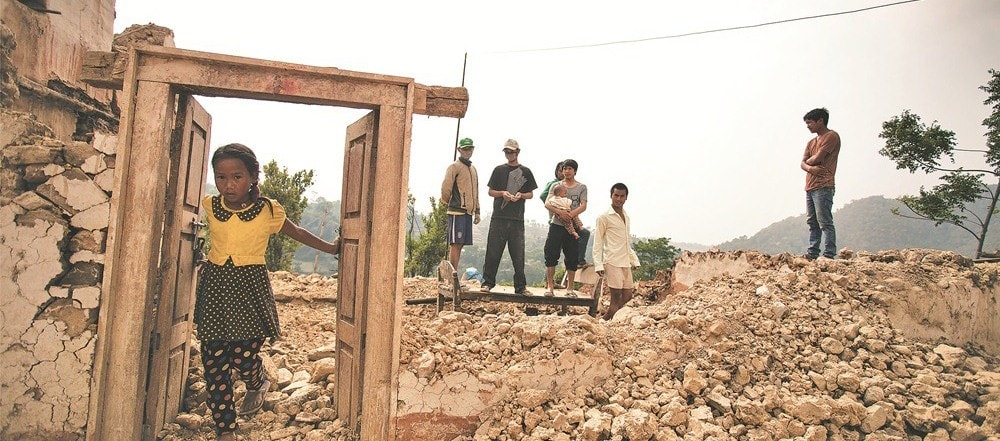
As the distribution of the housing reconstruction grants begins to pick up pace, rampant irregularities threaten to derail the legitimacy of the rebuilding process.
Jan 21, 2017- Like other earthquake-stricken families in Dadagaun of Sitapaila-5, Nagarjun Municipality, SB Tamang’s (name changed) extended family looks ideally fit to apply for just a single housing reconstruction grant worth Rs 300,000—an amount pledged by the government for each affected household.
Read More
Tamang, his four sons, their spouses and children were living under one roof until the house was reduced to rubble by the devastating earthquake of April 25, 2015. Tej Bahadur Giri says he does not know how to arrange extra money that would be required to build the house Sanu Tamang,70, says she is still waiting for relief
But when time came to register with the government to claim the housing grant and relief package, the Tamangs identified themselves as five separate families and applied accordingly.
The concerned authority swiftly issued an identification card in the name of Tamang’s four sons, acknowledging five members of the same family as separate beneficiaries of the promised aid.
Since then, SB and his four sons have already received Rs 25,000 each under two different relief packages distributed by the government and look set to receive the first tranche of the housing grant worth Rs 50,000, the distribution of which is underway.
Talking to the Post, the Tamang family maintained that they were living separately and using different kitchens, despite living in the same house.
“We were living separately in one house. It is the reason we applied separately for the grant. Since we have already spent more than Rs 600,000 to build makeshift shelters, we are thinking of paying back the moneylender with what we receive from the government,” said SB Tamang, referring to how the 12-member family has split into four makeshift shelters following the quake.
Like SB Tamang, B Giri’s (name changed) family of Irkhu Village Development Committee in Sindhupalchowk was ideally fit to receive a single package of earthquake reconstruction grants. The family had lost just one home in the disaster. But as time came to apply for the grant, Giri, and his eighty-year-old mother, who was under his care, registered themselves as two separate families. The mother-son duo too faced no obstacles enlisting themselves on the beneficiary roster.
“My mother was living separately in the barn. She started living with me after it sustained cracks during the earthquake. We are now using it just as a cow shed,” said Giri.
In November, Giri and his mother received the first tranche of Rs 50,000—-one for the house that was lost during the earthquake and another for the barn that sustained some damage during the earthquake but continues to house the family’s cow and goats.
Despite the Nepal Reconstruction Authority (NRA)—the government mechanism overseeing the reconstruction efforts nationwide—clearly warning against such maneuvering, stories like that of the Tamang and Giri families are becoming increasingly common as the process of distributing reconstruction grants begins to pick up pace.
Multiple factors, including the weak presence of the NRA and of government bodies at the ground level, a big say of cross-party local mechanisms in identifying earthquake victims and the lack of strong verification and monitoring mechanisms, have encouraged extended families to split into multiple units to rope in added monetary benefit. Widespread malpractice and the lack of oversight have also, in turn, encouraged even those whose houses were not affected by the quakes to claim government grants. 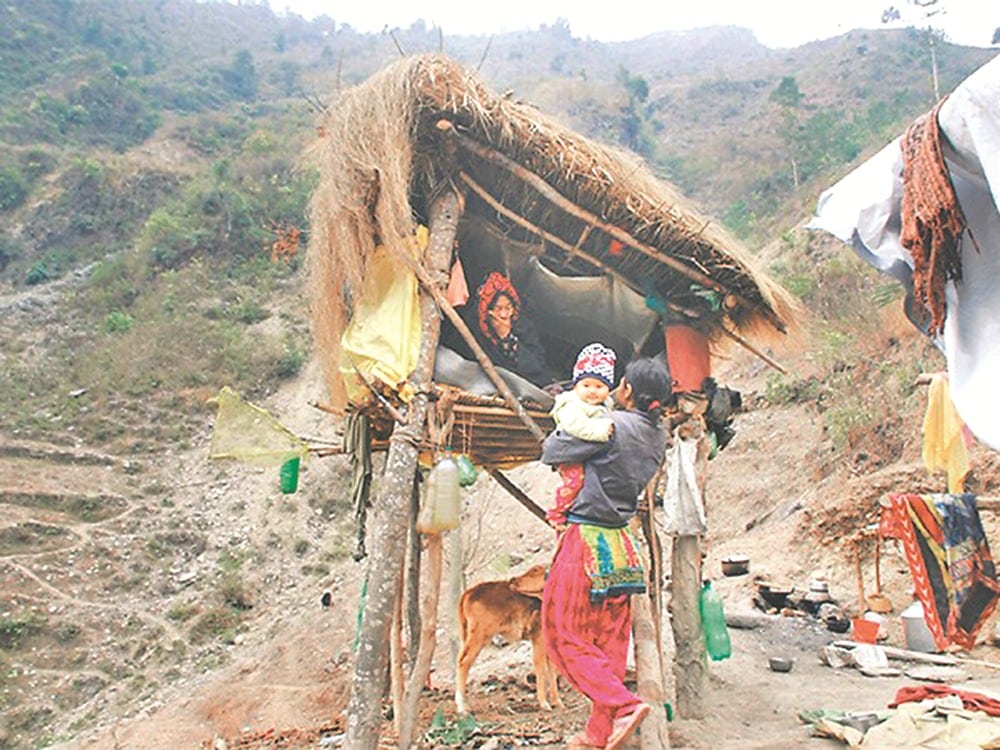
Outnumbered
In months that followed the 7.8-Richter Gorkha Earthquake, the Ministry of Home Affairs had carried out a Preliminary Damage Assessment survey to tabulate the extent of destruction caused by temblor and its many aftershocks. The survey found that a total of 500,717 houses were fully destroyed and another 269,190 houses were partially damaged during the earthquakes.
Of them, a total of 66,636 houses were destroyed in Sindhupalchowk, one of the worst-hit districts. Taking this into consideration, local stakeholders, including officials at the District Administration Office, were initially expecting to receive a similar number of applications for the housing grant.
At the most, authorities believed that the total applicants would not exceed 70,000. The National Population Census conducted in 2011, after all, had registered 66,688 households in the district.
But once the applications started pouring in, the number of affected households had shot up by more than 17 percent than what the preliminary assessment report had indicated.
Till date, more than 78,000 households have already received the first tranche of the housing grant in the district and an additional 18,000 have filed fresh applications to be enlisted as beneficiaries claiming that they were left out of the list the first time.
Like Sindhupalchowk other districts too have recorded a dramatic increase in the number of the affected households. In Dolakha, a district bordering Sindhupalchowk, there were 45,688 households in 2011, according to the last census. But 51,762 affected households have already received the first installment of the grant in the district till date, while an additional 21,712 families have filed an application seeking aid claiming they were overlooked during the registration process.
The same pattern could be spotted elsewhere in other districts identified as worst-hit by the quakes. In 11 districts where the NRA has nearly finished distributing the first installment of grants, there were a higher number of recipients than what was shown by the Preliminary Assessment Survey. The number of identified beneficiary households has gone well and above the number of total households registered in the 2011 census in Sindhupalchowk, Dolakha, Rasuwa, and Nuwakot. And while it may be too early to ascertain an exact number of beneficiaries of the housing grant, as the verification process is still underway in Kathmandu, Bhaktapur, and Lalitpur, NRA officials’ estimate the final number of the recipients could reach as high as 700,000.
More than 94 percent, from a total of 531,961 earthquake affected households identified so far in 11 districts, have already received the first installment of the grant, while an additional 160,000 families have filed applications seeking to get onto the roster. The number will go up even further, up to 30 percent, if the NRA decides to enlist the pending applications.
In other words, the government may end up spending as much as Rs 250 billion, more than one third of the total estimated budget for reconstruction, on private homes alone. The government had expected to complete the reconstruction project with a budget of Rs 669.50 billion, although recent NRA estimates indicate that the cost could go up by at least 25 percent.
“There is a danger that the large scale irregularities, if not checked in time, might lead to a full blown crisis. There is a need for strong, proactive intervention if we are to prevent a failure of the reconstruction project,” said a NRA official, who requested anonymity.
A catastrophe in waiting
Because of the discrepancies seen in the registry of the affected and of the handing out of housing grants, disgruntlings are already beginning to brew on the ground. Locals are increasingly angry with the government for providing money to ‘fake’ victims while leaving out those who were genuinely affected. And with the irregularities coming into the limelight, stakeholders have already started shifting the blame onto each other. NRA officials have been pointing to local administrations, local administrations are passing the blame onto NRA units on the ground, and the local NRA units are blaming cadres of political parties and local parties, on their part, are passing the blame down to the people.
During a field visit, the Post found that an interplay of multiple factors have provided a fertile ground for the irregularities in the quake-hit districts.
There is a growing sense of insecurity among affected families, especially the poorest, who are not in a position to manage the funds required to rebuild their houses on their own. And because the aid pledged by the government is not sufficient to build a home, malpractices have become commonplace.
“It would cost at least Rs 5 lakhs—excluding cost of labour—to build a home, as per the earthquake resilient design approved by the government. I still don’t know how to arrange extra money that would be required to build the house,” said Tej Bahadur Giri, 55, an earthquake victim in Irkhu, Sindhupalchowk.
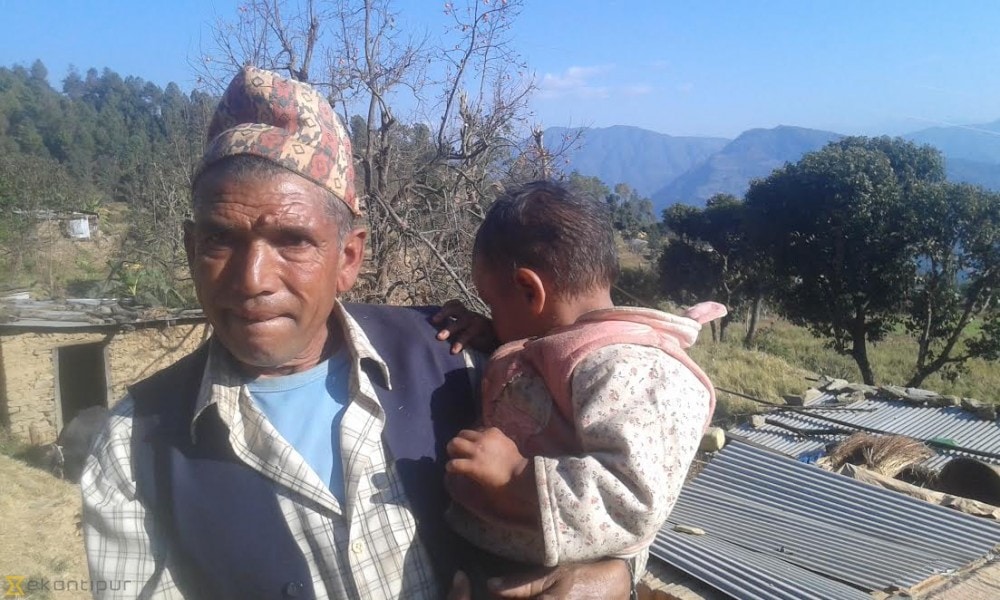
“The government should either increase the amount or let us build homes the way we like. We would have started building our homes long ago had the government not tied our hands with criteria that are hard to meet without increasing the grant amount. It’s beyond our capacity to build the exact design prescribed by the government,” said Giri.
Not just the affected families, the Post found an equally alarming number of families unaffected by the earthquake registering themselves for government aid in Kathamandu Valley and many villages in Sindhupalchowk and Dhading that it visited for reporting.
“More than 80 families have received grants in our village though nothing happened to their houses. But genuine victims were removed from the list of beneficiaries. We lodged a complaint at the VDC office, asking the administration to punish fraud and provide grant to real victims. The district administration had assured us that it will probe into the matter but nothing has happen yet,” said Binod Shah, a local of Jogimara village of Dhading district. There are around 1500 household in Jogimara.
“Someone who had long migrated from our village, nearly two decades ago, is on the list of beneficiaries, listing a long abandoned home. In fact, three members of that same family have been enlisted showing a house, a cottage and a barn separately,” he said.
Shah leads a struggle committee formed by 450 families ‘genuinely affected by the earthquake’ but excluded from the beneficiary list. Recently, the committee even padlocked the Village Development Committee Office demanding action against culprits and justice for genuine victims.
According to Shah, at least 350 households in the struggle committee are illegible for the full reconstruction grant. The situation is similar in neighbouring villages, including Dhusa, where several victims are campaigning for justice for genuine victims and are demanding punishment for fraud.
“People with connections easily registered themselves with the NRA although their house sustained just minor cracks. But the poor were left behind even though they lost their houses. It’s a common problem across the district,” said Chandra Silwal of Dhusa VDC, Dhading. 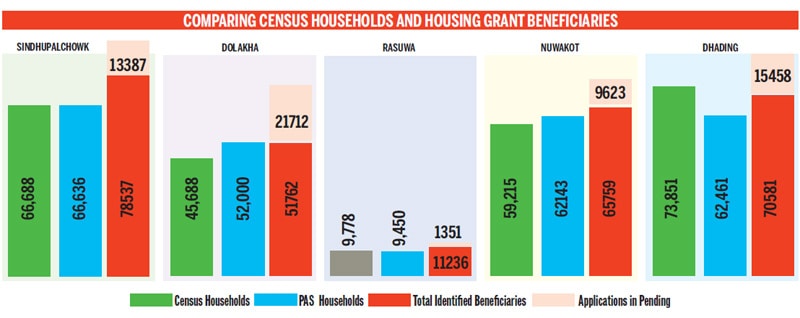
It is not hard to ascertain
how ‘fake’ victims managed to find a place in the list of beneficiaries, as Nepal is literally functioning without local administrations. The country has not held local-level elections since 1999. In absence of elected local representatives accountable to the people, local administrations have been in control of a nexus of local cross-party politicians.
This cross-party mechanism of local bodies has a decisive say on all local matters. And the NRA is increasingly dependent on them to carry out all activities, including vetting the list of earthquake victims. But instead of assisting the NRA in distinguishing ‘fake’ victims, the mechanism is increasingly becoming an instrument to misuse the state coffer to appease party cadres and loyalists.
The legal ambiguities have not helped either. The existing laws state that one destroyed household may constitute more than one family but doesn’t specify the limit. There are no clear laws to define what makes a single household eligible for multiple grants. The laws also fail to explain what makes a family eligible to be included in the list of beneficiaries. The Post found that many families were enlisted as beneficiaries of the full grant amount although their house sustained only minor cracks.
Ambiguities like these have encouraged many to resort to wrongdoing with little fear of repercussion and the lack oversight from the government is another important factor encouraging the anomalies on the ground.
The Ministry of Home Affairs did issue a circular last year directing district administrations to take action against ‘fake’ victims following reports of increasing complaints against rampant irregularities in the distribution of the first two packages of immediate relief—Rs 10,000 and Rs 15,000 respectively. The NRA’s local chapters have received more than 10,000 complaints against ‘fake’ earthquake victims. Around 8,000 complaints were received in Nuwakot district alone. Only a 1,000; however, have returned the amount they were handed by the government, according to local administrations of the 14 most affected districts.
NRA officials said that they are bringing a new set of laws in place to discourage disingenuous earthquake victims as the existing laws are unclear and are incapable of combating such a large-scale fraud.
The proposed laws endow the local administration with the authority to charge ‘fake’ victims with fraud as per provision enlisted in the civil code. It also envisions stringent action against the concerned staffers who were accrediting their applications and distributing the grant.
“We are aware about such irregularities but our main focus right now is to complete the reconstruction as it’s already very late. Those not building houses despite receiving grants will be punished,” said Govinda Pokharel, the CEO of the National Reconstruction Authority. Pokharel, however, said that the NRA is sensitive about not leaving out genuine earthquake-affected families.
“Last week, the NRA had cleared 70,000 complaints. Many new families have been enlisted in the beneficiaries’ list. We will look into other complaints gradually,” said Pokharel. NRA has added 18,000 families in the final list from 11 districts.
Pokharel, who recently replaced Sushil Gyawali as the CEO of the NRA with promises to do better than his predecessor, faces manifold challenges in the successful completion of the multi-billion reconstruction project. The biggest challenge, however, will be curbing the misuse of funds, all the while, ensuring that genuine victims are not left out. 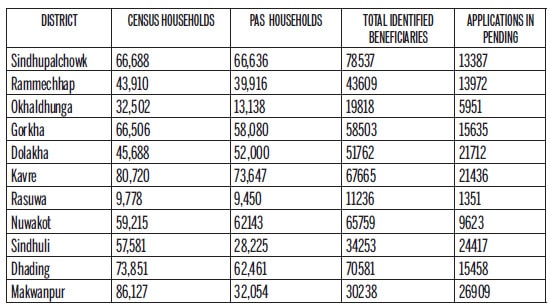
* Total identified beneficiaries: – Identified as earthquake victims by NRA (Source NRA: Till December 15, 2016)
*PAS: – Preliminary Assessment Survey conducted by the Ministry of Home Affairs, 2015
*Applications in Pending: – New application registered alongside other complaints
*Census Household: – National Population and Housing Census, 2011 
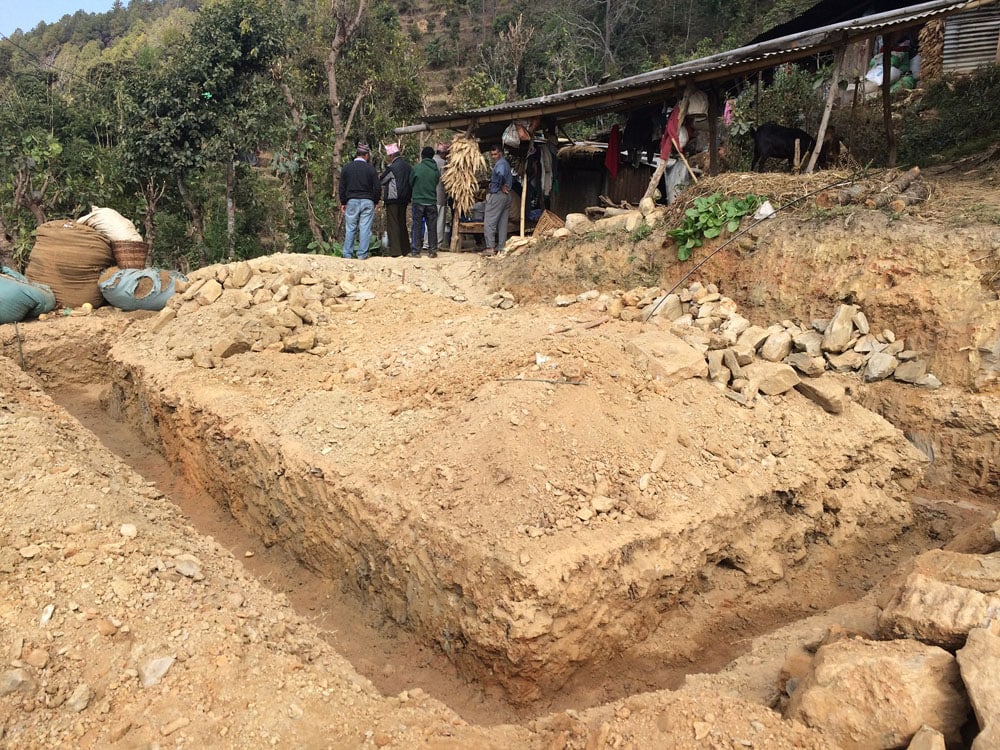
७.५ लाख
पूर्ण क्षति भएका घर संख्या ५.४५ लाख
घर बनाउन अनुदान सम्झौता गर्ने घर धनीको संख्या ४१,३११
पुनर्निर्माण सम्पन्न घर २०,८७९
निर्माणाधीन घर
नेपालमा विनाशकारी भूकम्प गएको झण्डै २० महिनापछि पुनर्निर्माणमा संलग्न विभिन्न राष्ट्रिय तथा अन्तर्राष्ट्रिय गैरसरकारी संस्थाहरु (एनजीओ तथा आइएनजीओ)ले भूकम्प पीडितहरुलाई ९ सय भन्दा कम घर बनाइदिएको पाइएको छ।
यो गत डिसेम्बर महिनाको अन्त्यसम्म बीबीसीलाई प्राप्त तथ्यांकको आधारमा थाहा भएको जानकारी हो।
बीबीसीले भूकम्प पीडितलाई घर बनाइदिने प्रतिबद्धता जनाएका विभिन्न संघ संस्थाहरुसँग उनीहरुको कामको प्रगतिबारे सोधपूछ गर्दा उक्त तथ्य बाहिर आएको हो। ती संघ संस्थाहरुले करिब २२ हजार घर बनाउन राष्ट्रिय पुनर्निर्माण प्राधिकरणसँग सम्झौता गरेका छन्। हालसम्म त्यस्ता कतिपय संस्थाहरुको काम आफ्नो अपेक्षा अनुरुप नदेखिएको अधिकारीहरुले बताएका छन्।
| संस्था | बनाइदिने घर संख्या | निर्माणाधिन घर संख्या | निर्माणसम्पन्न घर संख्या | प्रस्तावित लागत | हालसम्मको खर्च |
| वर्ल्ड रिन्यु | ३३२(घटाएर २८५) | २८ | ८ | २४ करोड | ४ करोड ८१ लाख |
| ह्याबिट्याट फर ह्युमानिटी | ३५०(बढाएर ५७०) | ३१ | ४ | ३८ करोड | ८ करोड ८६ लाख |
| नेपाल रेडक्रस सोसाइटि | ६,७१२(बढाएर ७,०४७) | ७०६ | ९२ | ७ अर्ब ३७ करोड | २९ करोड १ लाख |
| सेभ द चिल्ड्रेन | १,६०३ | ८२९ | १०० | ९ अर्ब ८७ करोड | ८ करोड |
| लुथरन वर्ल्ड फेडरेशन | २,३१३(घटाएर १,५५१) | २६८ | ३६ | ८८ करोड ९३ लाख | १० करोड ९५ लाख |
| समारिटन पर्स | ६१६(घटाएर ५००) | ५६ | ५५ | २५ करोड | उपलब्ध भएन |
| लुमन्ती सपोर्ट ग्रुप फर शेल्टर | १,४०० | १५४ | १०८ | ३० करोड ६९ लाख | उपलब्ध भएन |
| कारितास नेपाल | ४,३९१ | ४७९ | २९२ | १ अर्ब ५६ करोड | २१ करोड |
क्षती
भूकम्पबाट करीब साढे सात लाख घरहरु क्षति भएको सरकारी आँकडा छन्।

८८०
निर्माण गरिदिएको घर संख्या २१,९७१
निर्माण गर्ने प्रतिबद्धता जनाएको घर संख्या २६ अर्ब ७० करोड
घर बनाउन लाग्ने प्रस्तावित लागत ३,२०४
अहिले निर्माणाधीन घर संख्या
तर विपद लगत्तैको उद्धार तथा राहत गतिविधिमा सक्रिय भएका धेरै एनजीओ तथा आइएनजीओ मध्ये २४ वटाले मात्रै भूकम्प पिडीतका घर पुनर्निर्माणमा सघाउन सरकारसँग सम्झौता गरेका थिए। त्यसरी अनुमति लिएका मध्ये केही संस्थाहरुले घर निर्माणको काम सुरु समेत गर्न सकेका छैन्।
| संस्था | बनाइदिने घर संख्या | निर्माणाधिन घर संख्या | निर्माणसम्पन्न घर संख्या | प्रस्तावित लागत | हालसम्मको खर्च |
| उज्यालो गाउँ निर्माण अभियान | १८० | २ | ० | ४ करोड ३३ लाख | ६२ लाख ७६ हजार |
| हेल्भेटास | १,००० | ३६ | ५४ | ४६ करोड ५९ लाख | ३ करोड ६ लाख |
| धुर्मुस सुन्तली फाउन्डेशन | ६५ | ६५ | ३ करोड २५ लाख | ५ करोड १७ लाख | |
| वर्ल्ड भिजन इन्टरनेश्नल | ३०० (बढाएर ३०७) | ११ | १ | १६ करोड ३३ लाख | १ करोड ७९ लाख |
| नेपाल जेसुइट सोसाइटी | १०३ | अनुगमन बाँकी | ० | २ करोड ५३ लाख | ५० लाख |
| इडब्लुडिइडिकेएच | २५० | लाभग्राही सूची ढिलाइले काममा बाधा | ० | ११ करोड ७० लाख | ५० लाख |
| टियर फन्ड | ६०० | नक्साङकन ४०२ (दोस्रो किस्ता १९६) | १६ | २३ करोड ३० लाख | ७ करोड १७ लाख |
| आइएनएफ नेपाल | १०८ | ६ | २४ | ३ करोड ४२ लाख | ५२ लाख ५० हजार |
घर बनाउन रकम पाउने लाभग्राहीको सूची प्रकाशनमा भएको ढिलासुस्ती तथा पुनर्निर्माण प्राधिकरणको नीतिगत अन्योललाई कतिपय संघ संस्थाले दोष दिएका छन्।
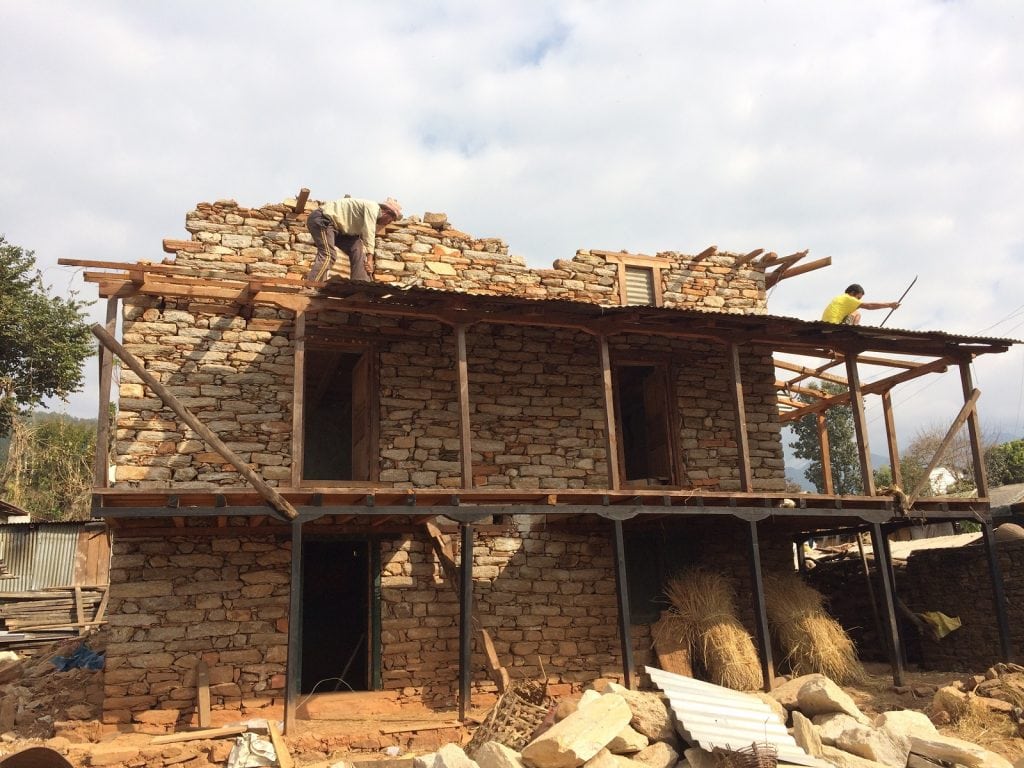
२४
घर बनाउन अनुमति प्राप्त संस्था ८
हालसम्म एउटा पनि घर बनाउन नसकेका संस्था १९
सयभन्दा बढी घर निर्माणको अनुमति लिएका संस्था ३
सयभन्दा बढी घर बनाइसकेका संस्था
तर प्राधिकरणका अधिकारीहरु चाँहि खासै नितीगत समस्या नरहेको बरु एनजीओ आइएनजीओले नियमित रुपमा आफ्नो कामको प्रगति विवरण आफूलाई नबुझाएर उनीहरुका कामका बारेमा बेखबर बनाएको बताउँछन्। गैरसरकारी संस्थाहरुले घर पुनर्निर्माण कार्यक्रम अन्तर्गत करिब २६ अर्ब ७० करोड रुपैयाँ बराबरका विभिन्न कामका लागि स्वीकृति लिएका छन्। उनीहरुले १७ हजार भन्दा बढी भूकम्प पीडितलाई ५० हजार रुपैयाँका दरले करिब ८६ करोड ७० लाख रकम पहिलो किस्ताका रुपमा उपलब्ध गराएको जानकारी दिएका छन्।
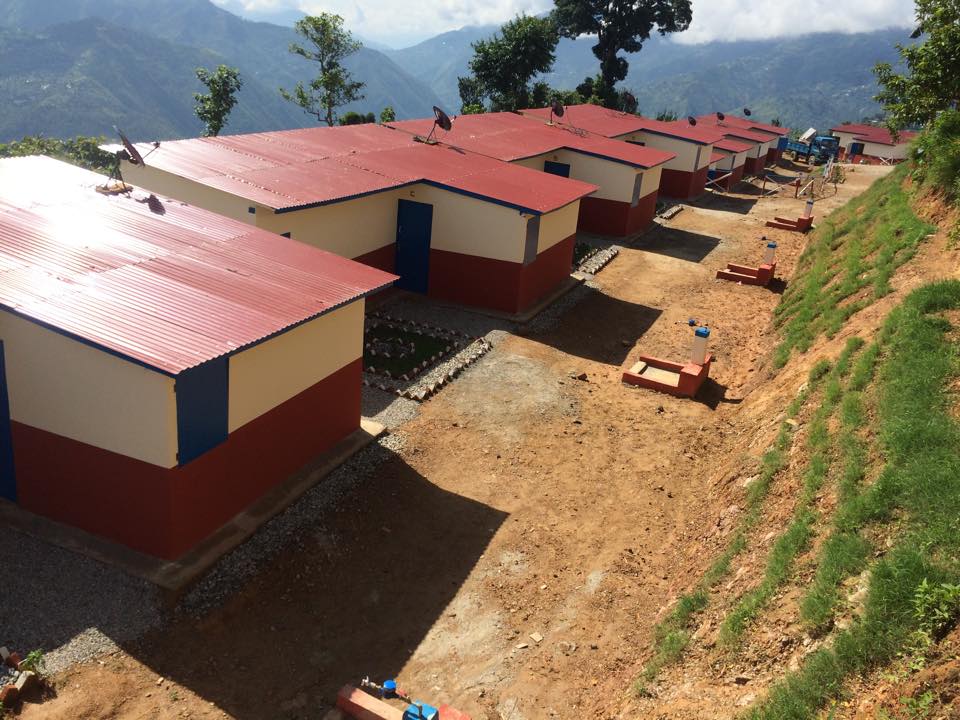
१
धुर्मुस सुन्तली फाउन्डेशन ६५
बनाइदिएको घर संख्या ५ करोड १७ लाख
घर बनाउन लागेको लागत
बीबीसीले उनीहरुसँग हालसम्म खर्च भएको रकमबारे जानकारी माग्दा केही संघ संस्थाले सम्बद्ध निकायलाई आफूले विवरण उपलब्ध गराएको भन्दै जानकारी दिन अस्वीकार गरेका थिए।
| संस्था | बनाइदिने घर संख्या | निर्माणाधिन घर संख्या | निर्माणसम्पन्न घर संख्या | प्रस्तावित लागत | हालसम्मको खर्च |
| एनआरएन | ५७३ | नक्साङ्कन/ माटो सम्याउने काम सुरु | ० | २८ करोड८९ लाख | जनश्रम जुटाएर आफैँ बनाउने |
| सहयोगी हातहरुको समूह | ५९ | १५ | ० | १ करोड ५५ लाख | उपलब्ध भएन |
| चोइस ह्युमेनिटेरियन नेपाल | ७० | २२ | ८ | १ करोड ५५ लाख | करिव ३० लाख |
| मेडएअर | ३१० | ५७ | ३ | १० करोड ५६ लाख | १ करोड ९३ लाख |
| लुथरन वर्ल्ड रिलिफ | ३०० | ४० | १४ | ९ करोड ९५ लाख | ५० लाख |
| ओरेक नेपाल | ५० | काम सुरु गर्ने तयारी | ० | ३ करोड ७ लाख | |
| एसओएस भिलेज नेपाल | २७० | ६२ | ० | ९५ करोड | १० करोड |
| माल्टिजर इन्टरनेश्नल | २५५ | काम सुरु गर्ने तयारी | ० | २१ करोड |
घर निर्माण लगायत विभिन्न क्षेत्रमा भूकम्पपछि काम गरिरहेका संघसंस्थाको सरकारी अनुगमन साह्रै फितलो रहेको गुनासो बेला बेलामा सुनिने गरेको छ।
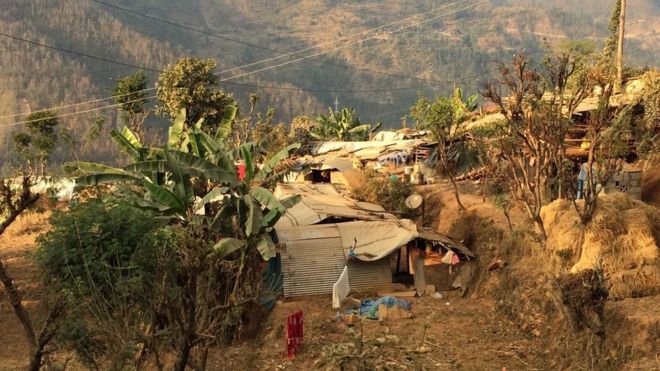
झण्डै दुई वर्षअघिको विनाशकारी भूकम्पबाट पीडितहरुका लागि विभिन्न गैरसरकारी संस्थाले अहिलेसम्म नौ सयभन्दा कम घरहरुमात्रै बनाएको बीबीसीले गरेको एउटा अध्ययनले देखाएको छ।
भूकम्पपछि पुनर्निर्माण गरिनुपर्ने करिब सात लाख घरहरुमध्ये २२ हजार घर बनाउने वाचा संस्थाहरुले गरेका थिए।
पुनर्निर्माण प्राधिकरणले उक्त प्रगति त्यति सन्तोषजनक नभएको प्रतिक्रिया दिएको छ। तर आफ्नो काम सुस्त हुनुमा संस्थाहरुले पुनर्निर्माण प्राधिकरणको नीतिगत ढिलासुस्तीलाई दोष दिएका छन्। साथै केहीले आफ्नो काममा प्रगति हुन नसके दाताहरुले दिएको रकम त्यसै फिर्ता जान सक्ने सम्भावनातर्फ पनि संकेत गरेका छन्। काम २० महिनाअघि गएको विनाशकारी भूकम्पबाट निकै प्रभावित क्षेत्रमध्ये सिन्धुपाल्चोक जिल्लाको ठोकर्पा गाविस पनि पर्छ जहाँ झण्डै ८५ हजार घर पूर्ण रुपमा क्षतिग्रस्त भएका थिए। अरनिको राजमार्गको सुकुटेबाट करिब एक घण्टा कच्ची पहाडी बाटोको यात्रापछि पुगिने उक्त गाउँमा अहिले एकाध परिवारमात्रै आफ्नो घर बनाउने काममा व्यस्त छन्। ठोकर्पा माध्यमिक विद्यालयका शिक्षक क्षेत्रमणि कोइराला अझै अन्योलमै छन्।
अब बुढाबुढी भइसकियो, मलाई घर बनाउन रहर छैन
-पदमबहादुर सार्की, भूकम्प पीडित, दोलखा
शिक्षक क्षेत्रमणि कोइराला अझै निर्णयमा पुग्न सकिरहेका छैनन्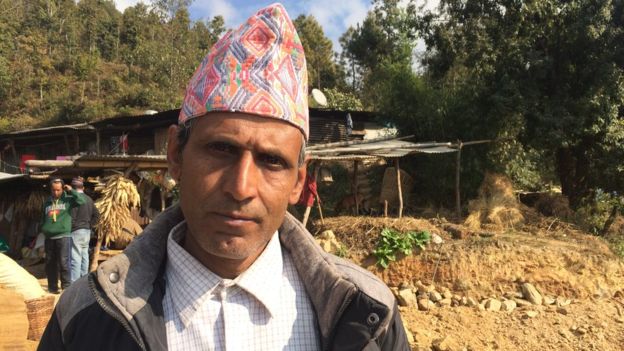
उनले भने, "अरुले बनाउन भर्खरै थालेका छन्, अर्को वर्षसम्ममा म पनि बनाउँछु, राज्यले पनि पाँच वर्षभित्र बनाउनु भनेको छ, यहाँ अहिले घर बनाउने दक्ष जनशक्ति छैन। पालो पर्खिनुपर्ने हुनाले अलिकति समय लागेको हो।" आफ्नै हातमा सीप भएकाहरु चाहिँ आफैं खटिएर भएपनि घर बनाउन थालेको देखिन्छ। पेशाले डकर्मी ३० वर्षे कुमार रोका यसै हिउँदमा ढुँङ्गा र माटोले बनाएको आफ्नो नयाँ घरमा सरिसके। दुई बालबच्चाका अभिभावक कुमार भन्छन्, "धेरै ठूलो लगानी गर्न नसक्ने हुनाले ढुङ्गा माटोको घर बनाएँ। पाएको पैसामा अलि अलि थपेर, धेरै रुपैयाँ आफैंले थपेर सहकारीबाट ऋण सापट गरेर घर बनायौं।" उनी भूकम्पपछि ठोकर्पामा घर बनाउन सफल औँलामा गन्न सकिने मानिसहरुमा पर्छन्।
हालै बनाइसकेको घरमा आफ्ना वुवासँग कुमार रोका
आशंका
ठोकर्पाका सबै क्षतिग्रस्त घरको पुनर्निर्माण गर्ने जिम्मेवारी लिएको संस्था कारितास नेपालले करिब सवा एघार सय व्यक्तिलाई पहिलो किस्ता वापतको प्रति परिवार ५० हजार रुपैयाँ उपलब्ध गराएको बताएको छ। तर ठोकर्पा गाविस कार्यालय अनुसार अहिलेसम्म ११० जनाले मात्रै घर बनाउने अनुमतिका लागि निवेदन दिएका छन्।
कारितास नेपालले ठोकर्पा गाउँको पुनर्निर्माणमा सघाइरहेको छ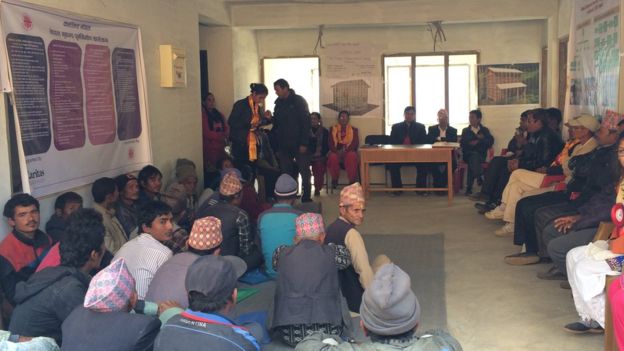
सिन्धुपाल्चोक सहित तीन जिल्लामा ४ हजार ४ सय घर निर्माण गरिदिने प्रतिवद्धता जनाएको कारितास नेपालले करिब ३०० सेवाग्राहीले घर बनाइसकेको र झण्डै पौने पाँच सयले घर बनाउन थालेको जनाएको छ। कारितास नेपालका कार्यक्रम शाखा प्रमुख मणीन्द्र मल्ल भन्छन्, "हामीले सेप्टेम्बरमा नै पहिलो किस्ता दिइसकेका थियौं। दशैँ तिहार लगायत चाडपर्व बीचमा पर्यो। बाली काटिससकेपछि उहाँहरुले ध्यान दिएर घर बनाउन थाल्नुभएको हो, जम्मा एक दुई महिना त भयो, हामीले सके जति सहयोग पुर्याइरहेका छौँ।" अबको दुई वर्षभित्र सबै घर बनाइसक्ने लक्ष्य निर्धारण गरेको कारितास नेपालले त्यसअनुसार डकर्मी र इन्जिनियरलाई तालिम दिएर गाउँहरुमा खटाएको जनाएको छ। तर घर निर्माणमा देखिएका सुस्तता हेर्दा उक्त लक्ष्य साँच्चै पूरा हुनेमा आंशका गर्नेहरु धेरै छन्। निर्माणाधीन सिन्धुपाल्चोकसँग नै जोडिएको दोलखा जिल्लामा पनि विभिन्न संस्थाले भूकम्प प्रभावितहरुका लागि घर निर्माण गराइदिने प्रतिबद्धता जनाएका छन्। तामाकोशी नदी तरेपछि जिरी जाने पिच सडकबाटोकै छेउमा पर्ने नाम्दु गाउँका १०० घर निर्माणका लागि अन्तर्राष्ट्रिय गैरसरकारी संस्था 'सेभ द चिल्ड्रेन'ले मद्दत गरिरहेको छ। एउटा संस्थाको लेखापालका रुपमा काम गर्ने गरेका नाम्दु भिरमुनीका मनोज गहतराज दुई महिनाको बिदा लिएर आफ्नो घर निर्माणमा आफैं भिडिरहेका छन्। माघको पहिलो हप्तासम्ममा घरको गाह्रो लगाउने योजना बनाएका उनी भन्छन्,"ढुङ्गा माटोले तीन लाख रुपैयाँमा बन्ने खालको घर निर्माणको योजना हामीले गरेका छौँ।"
प्रक्रियाबारे स्पष्ट नहुँदासम्म कतिपयले संघसंस्थाको सहयोगमा घर नबनाउने धारणा राखे, भनाइ र व्यवहार दुवैमा ढिला काम शुरु भयो-पिट लराँस, निर्देशक, सेभ द चिल्ड्रेन
नाम्दुमा पनि पुनर्निर्माणले गति लिएको छैन
दुई सन्तानकी आमा रहेकी नाम्दुकै मसली तामाङले भने अझै घर बनाउन सकिरहेकी छैनन्। खेतीपातीको कामले फुर्सद नहुँदा घर बनाउन ढिलो भइरहेको भन्दै उनले भनिन्, "धेरै जग्गा छैन त्यही भएर यहाँ थुपारिएको मल अर्को ठाउँमा सारिसकेपछि यो टहरा हटाएर, ढुंगा पन्छाएर घर बनाउँला भनेको छु। पैसा ५० हजार छ, त्यतिले त पुग्दैन तर दोस्रो किस्ता आउँछ होला नि।" दोलखासहित चार जिल्लामा १६ सय ३ वटा घर बनाउन सहयोग गर्ने बताएको 'सेभ द चिल्ड्रेन'ले वृद्धवृद्धा तथा एकल महिला लगायत अझ बढी जोखिममा रहेका समुदायसँग काम गरिरहेको बताएको छ। तर त्यस्ता सेवाग्राहीसँग काम गर्दाका आफ्नै चुनौती छन्। नाम्दु मैनापोखरीका पदमबहादुर सार्की चाहिँ आफ्नो परिवारमा छोरा नभएका कारण घर नबनाउने अडान लिएर बसिरहेका छन्।
पदमबहादुर सार्की टहरामै बस्ने भनेर अडान लिइरहेका छन्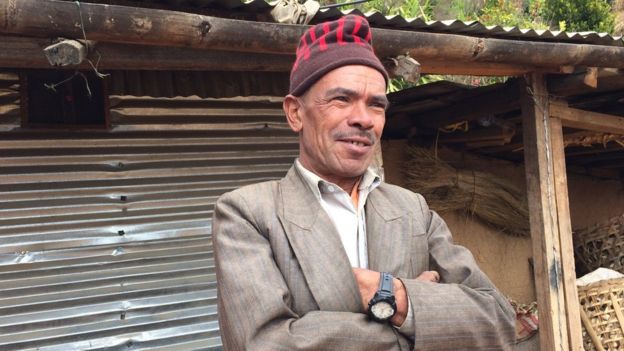
उनी भन्छन्, "अब बुढाबुढी भइसकियो, मलाई घर बनाउन रहर छैन, छोरा नभएको मान्छे कसलाई बनाइदिनु? दोस्रो किस्ता पनि चाहिँदैन्, आफू घर बनाउन सक्दिन, त्यही भएर नबनाउने भनको हुँ।" नाम्दु गाविसका सचिव जयराम घिमिरेले 'सेभ द चिल्ड्रेन'ले सघाएका ९७ लाभग्राहीमध्ये करिब ४० जनाले पुनर्निर्माणको काम गरिरहेको जानकारी दिए। आगामी वैशाखसम्ममा सबै घर निर्माण सम्पन्न गर्ने लक्ष्य रहेको जनाउँदै सेभ द चिल्ड्रेनले भने आफूले काम गरिरहेका चार जिल्लामा झण्डै सवा नौ सय जनाले घर पुनर्निर्माणको काम अघि बढाइसकेको बताएको छ।'सेभ द चिल्ड्रेन'को नेपालस्थित कार्यालयका मानवीय सहायता कार्यक्रमका निर्देशक पिट लराँसले ठूला विपद्पछि हेइटी जस्ता देशमा पनि शुरुका केही वर्ष आवास निर्माणमा नेपालमा जस्तै विलम्ब भएको बताए। आवास निर्माणमा देखिएका सुस्तताबारे उनी भन्छन्, "शुरुमा त पुनर्निर्माण प्रधिकरण बन्न र उसलाई आफ्नो नियम नै ल्याउन एक वर्ष लाग्यो, ब्याङ्किङ् प्रणालीबारे निर्णय गर्न पनि समय लाग्यो।" "कहिले र कति रकम दिने भन्नेबारे अन्योल भयो। प्रक्रियाबारे स्पष्ट नहुँदासम्म कतिपयले संघसंस्थाको सहयोगमा घर नबनाउने धारणा राखे। साँच्चै नै भनाइ र व्यवहार दुवैमा ढिला काम शुरु भयो।" बेखबर
पुनर्निर्माण प्राधिकरणसँग विभिन्न २४ वटा संघसंस्थाले झण्डै २२ हजार घर निर्माण गर्न त्रिपक्षीय सम्झौता गरेका थिए।
जुन गतिमा प्रगति हुन्छ भनेर हामीले अपेक्षा गरेका थियौं, त्यो गतिमा प्रगति नभएको अवस्था छ– भीष्मकुमार भुसाल, सहप्रवक्ता, पुनर्निर्माण प्राधिकरण
सुरक्षित निर्माणका लागि चेतना अभियानमा पनि एनजीओ/आइएनजीओले रकम खर्च गरिरहेका छन्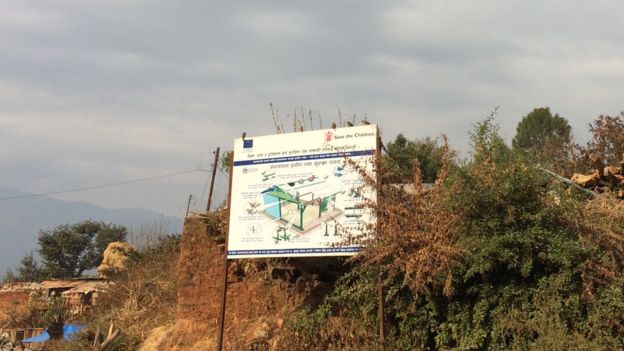
सरकारले भूकम्प प्रभावितलाई उपलब्ध गराउने अनुदान रकम दुई लाखबाट बढाएर तीन लाखसम्म पुर्याएपछि कतिपय संस्थाहरुले बजेट मिलानका लागि बनाइदिने घरको संख्या कटौती गरिरहेका छन्। ती संस्थाहरुले झण्डै २६ अर्ब ७० करोड रुपैयाँ बराबरका कार्यक्रम सञ्चालन गर्ने स्वीकृति लिएपनि उनीहरुले अहिलेसम्म कति खर्च गरे र कति घर बनाए भन्ने विवरण आफूहरुसँग नभएको सरकारी निकायहरु बताउँछन्। पुनर्निर्माण प्राधिकरणका सहप्रवक्ता भीष्मकुमार भुसाल भन्छन्,"जीविकोपार्जनतर्फ र निजी आवासतर्फ सहयोग पुर्याउने संस्थाहरुको हकमा जुन गतिमा प्रगति हुन्छ भनेर हामीले अपेक्षा गरेका थियौं, त्यो गतिमा प्रगति नभएको अवस्था छ, एकाध साझेदार संस्थाहरुले मात्रै नियमित रुपमा प्राधिकरणलाई तोकिएको समयमा काम गरी प्रतिवेदन बुझाएको अवस्था छ।"
प्रगति
भूकम्प प्रभावित व्यक्तिहरुलाई त्यसरी घर बनाइने सम्झौता गरेका सबै संघसंस्था, पुनर्निर्माण प्राधिकरण तथा जिल्लास्थित सरकारी अधिकारीसँग बीबीसीले सम्पर्क गरी संकलन गरेको जानकारीबाट हालसम्म राष्ट्रिय तथा अन्तर्राष्ट्रिय गैरसरकारी संस्थाहरुको सहयोगबाट अहिलेसम्म ८ सय ८० वटा मात्रै घर बनेको देखिन्छ। ती संस्थाहरुले आफूसंग सहयोग लिएका थप ३ हजार २ सय सेवाग्राहीले धमाधम घर बनाउन थालेको जानकारी दिएका छन्।
तर घर बनिरहेका भनिएका कतिपय गाउँका र जिल्लाका अधिकारीहरुलाई बीबीसीले सम्पर्क गर्दा संस्थाहरुले बनाउन सघाइरहेका घर निर्माणमा भइरहेका संख्यात्मक प्रगतिबारे अद्यावधिक जानकारी नरहेको जवाफ दिएका थिए। उसो त देशभर अहिलेसम्म ४३ हजार भन्दा केही बढी घर बनिसकेको र साढे १७ हजार घरमात्रै निर्माणाधीन अवस्थामा रहेको पुनर्निर्माण प्राधिकरणले जनाएको छ। प्राधिकरणसँग दशैँअघि नै अनुमति लिइसकेकामध्ये कम्तीमा तीनवटा संस्थाले अझै पनि प्रशासनिक प्रक्रिया पूरा गर्ने चरणमा रहेको बीबीसीलाई जानकारी दिएका छन्।
हामीले चाहेर पनि त्यो पैसा खर्च गर्न सकिरहेका छैनौँ– सतिश अर्याल, मूल्यांकन अधिकृत, लुथरन वर्ल्ड रिलिफ
समस्या
लम्जुङमा झण्डै दुई सय घर बनाउनका लागि अनुमतिप्राप्त गरेको 'लुथरन वर्ल्ड रिलिफ'ले लाभग्राहीको सूची सार्वजनिक नहुँदा आफ्नो निजी आवास कार्यक्रम नै संकटमा परेको जनाएको छ। उक्त संस्थाका मूल्यांकन अधिकृत सतिश अर्याल भन्छन्, "हामीले चाहेर पनि त्यो पैसा खर्च गर्न सकिरहेका छैनौँ, अप्रिलसम्म हामीले खर्च गरिसक्नुपर्ने सम्झौता गरेका छौँ। अप्रिलसम्म पनि लम्जुङका लाभग्राहीको सूची आएन भने सम्भवत: त्यो रकम फिर्ता जाने सम्भावना प्रबल रहन्छ।"
पीडितहरुले हिउँदमा घर नबनाए वर्षायाममा पनि उनीहरुको बास टहरामै हुने देखिन्छ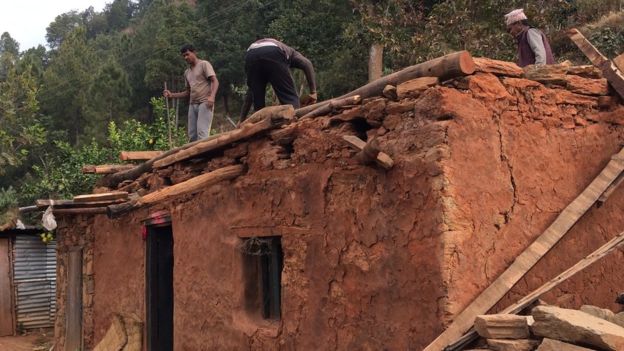
पुनर्निर्माण प्राधिकरणका सहप्रवक्ता भुसालले त्यस्तो समस्या धेरै ठाउँमा नरहेको भन्दै उक्त विषय सम्बोधन हुने बताए। कैयौँ संघसंस्थाका अधिकारीहरुले कागजपत्रको अभावमा कतिपय पीडितलाई आफूहरुले अनुदान दिन नसकेको र दोस्रो किस्ता वितरणसम्बन्धी कार्यविधि समयमा नआएपछि घर निर्माणका लागि उपलब्ध गराउन छुट्याइएको रकम त्यसै ब्याङ्क खातामा थन्किएको बीबीसीलाई बताएका छन्। पुनर्निर्माण प्राधिकरणले चाँहि दुई महिनासम्म दोस्रो किस्ता वितरणका लागि आवश्यक कार्यविधि मन्त्रिपरिषदमा थन्काएर ढिला गरी जारी गरिदाँ कतिपय त्यस्ता समस्या दखिएको जवाफ दिएको छ। आवास निर्माणमा संलग्न कतिपय राष्ट्रिय तथा अन्तर्राष्ट्रिय गैरसरकारी संस्था आफैं घर बनाउन खटिएका छैनन्। उनीहरुले स्थानीय स्तरका गैरसरकारी संस्थालाई आफ्ना कार्यक्रम सञ्चालनको जिम्मेवारी दिएका छन्। तीमध्ये केहीले आफूले घरहरु बनाइदिने नभइ पीडितलाई किस्ता वापतको रकम दिएर घर बनाउन सहयोग मात्र उपलब्ध गराइरहेकाले अझै पनि टहरामा बसिरहेका भूकम्प पीडितले घर बनाउने विषय आफ्नो नियन्त्रणमा नरहेकोसम्म बताउन थालेका छन्।
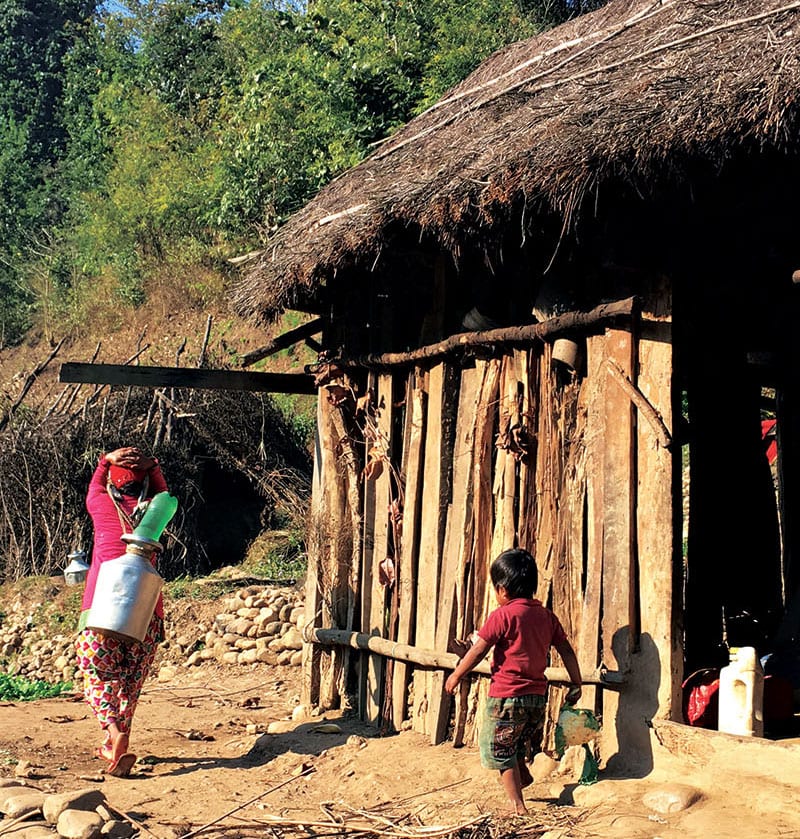
A child running after his mother as she fetches drinking water outside their makeshift shelter, in Hadikhola village, Makawanpur.
Whenever Urmila Blon (Tamang) can take a few minutes break from her farm work, she walks to the edge of the terraced field and enviously looks at the houses being rebuilt in the lower tiers at Hadikhola village of Makawanpur district.
Read More“We have been approaching the village development committee (VDC) office for the aid, but the officials there told us we need to present our land ownership certificate first,” said 35-year-old Blon.
A total of 300 affected households in the village, whose houses suffered irreparable damage during the devastating quake of 2015, are at the risk of being left out of the government’s housing grant because they do not have any land to their name and had been living in public property since many years. The plight of landless victims of Hadikhola area is compounded by the fact that most belong to marginalised ethnic communities like Chepang, Tamang and Sunar, among others.
The National Reconstruction Authority (NRA) started grant distribution process to the quake survivors living in makeshift shelters from March 13 of last year, nearly 11 months after the quake struck. While 82 per cent of the beneficiary households have already received the first tranche of Rs 50,000 to start rebuilding houses, the issue of landless victims is yet to be resolved.
“Since the grant distribution process started, the District Development Committee (DDC) has forwarded the list of beneficiary households to the concerned VDCs and municipalities for the purpose of signing grant agreement. However, due to lack of government’s policy to address the issue of landless victims, they are still deprived of the housing reconstruction aid despite being listed as beneficiary households,” explained Kisan Neupane, planning monitoring and administrative officer at the Makawanpur DDC.
NRA officials are also clueless about when the grant amount, a total of Rs 300,000, will be released to the landless victims. There is no legal provision to sign the grant agreement without the land ownership certificate, and the grant is released only after signing the agreement with local bodies in purview of NRA.
It is estimated that nearly a quarter of the population of the country are landless. Still, the issue of landless beneficiaries was overlooked while formulating the ‘Guidelines on Grant Distribution to Private Houses’ — the legal document to regulate the government aid for individual house reconstruction.
“Discussions related to the matter have been held time and again during the prime minister-led meetings of the NRA steering committee, but there has been no headway yet because if the government takes any decision regarding landless people without categorising the settlements on public land based on various indicators, it will also give legal status to the communities that are living rampantly by encroaching on government land,” a high-level NRA source told The Himalayan Times.
As per data collected by NRA, Makawanpur district has the highest number of landless quake victims — around 4,470 households out of the total 30,238 beneficiary households identified by the beneficiary survey of NRA. It is followed by Sindhuli, where 3,038 beneficiary households are landless out of the total of 34,269 eligible beneficiaries.
“As the government has been distributing housing reconstruction grant with the support of development partners, the government will not be able to justify distributing money to the families that are living on unregistered land and questions related to irregularities in housing grant distribution can be raised,” explained the NRA official, requesting anonymity due to the sensitivity of the matter.
So far, NRA has finished collecting data of landless victims from five districts — Makawanpur, Sindhuli, Dhading, Rasuwa and Sindhupalchowk, out of 14 severely affected districts, according to Yam Lal Bhoosal, spokesperson for NRA. “Data collection from other districts is also being carried out. We have estimated that there are around 21,000 landless households out of the total 626,696 beneficiary households listed as eligible to receive the government aid through the NRA survey.”
Initially, beneficiary households that had built homes on the land of guthi (collective ownership) and those having surveyed land but lacking land ownership certificates were also facing hassles in receiving the government aid. Their issue was resolved just a few months back and now they are receiving grant after they presented any kind of evidence of ownership, even if it has been issued by the local bodies — VDCs and municipalities. They are, nonetheless, asked to initiate the process of obtaining land ownership certificate from the District Survey Office and Land Revenue Office.
And while the government takes its time in making a decision on how to settle the issue of landless victims, the living condition of those like Blon is slipping from bad to worse.
“Those who have land and are more economically capable have been receiving grant to rebuild their lives, but there has been no respite for poor quake victims like us,” said Binda Chepang, another landless quake victim of Hadikhola VDC.
Forced to live hand-to-mouth by eking out a living by taking up odd jobs, the landless victims, however, continue to cling on to hope that things will turn around for them.
“We lost what little we had in the earthquake. Hope is all we have left now,” said Shanta Bahadur Chepang, 58, crouched outside the makeshift shelter in which he has already spent three winters.
A version of this article appears in print on February 16, 2017 of The Himalayan Times.
ABOUT
Seven reporters from seven Nepali media outlets worked for more than six months to document and explain delays in the reconstruction process following the April 2015 earthquake. They obtained and analyzed more than 6,000 pages of records from the National Reconstruction Authority and other organizations. The journalists used spreadsheets to track grant dispersals for mason training programs and to measure private donor’s promised efforts. To show the human cost of delays beyond just numbers, the journalists traveled into earthquake-hit regions to interview residents and officials.
The project is supported by a grant from the Fund for Investigative Journalism in Washington, D.C, and is coordinated by the Centre for Investigative Journalism-Nepal and Lucinda Fleeson, an American journalist and Fulbright Specialist
Arun Karki | Center for Data Journalism, Nepal Phanindra Dahal | BBC Nepali Service Pushpa Raj Acharya | The Himalayan Times Rajneesh Bhandari | Freelance Journalist Roshan Sedhai | The Kathmandu Post Rudra Pangeni | Republica Daily Shreejana Shrestha | Nepali Times